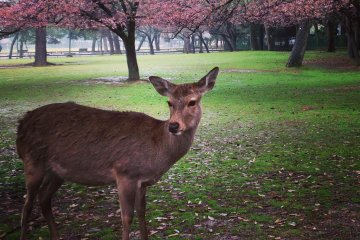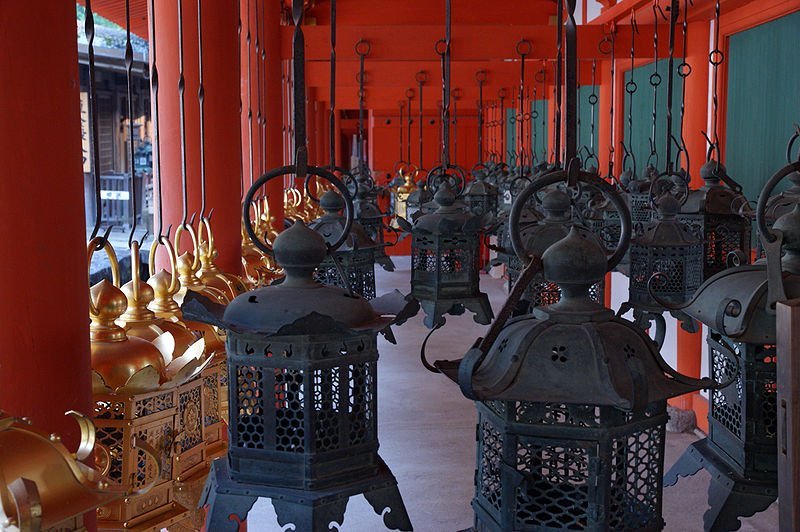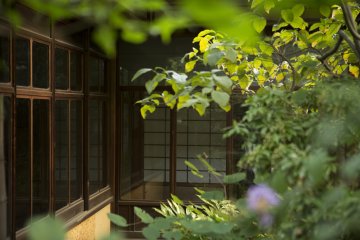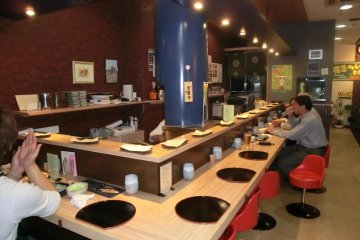
เพลิดเพลินเดินเล่นชมนารา พาร์ค
Stefanus Husinสวนสาธารณะขนาดใหญ่ทางตะวันออกของนาราที่จุเต็มไปด้วยกองทัพกวาง

นารา พาร์ค ตั้งอยู่ในเมืองนารา ได้ก่อตั้งขึ้นมาตั้งแต่ปี 1880 เป็นสวนสาธารณะที่กว้างใหญ่ และเป็นแหล่งรวมตัวของสถานที่ท่องเที่ยวหลักของนารา เช่น วัด Kofukuji พิพิทธภัณฑ์แห่งชาตินารา (Nara National Museum) และวัด Todaiji อีกสิ่งหนึ่งที่ทำให้เมืองนารามีชื่อเสียงมากคือ เหล่ากองทัพกวางที่อาศัยอยู่ในสวน และกวางเหล่านี้ก็ได้กลายมาเป็นสัญญาลักษณ์ของเมือง
สวนแห่งนี้ครอบคลุมเนื้อที่ทางตะวันออกของนาราเกือบทั้งหมด เมื่อคุณเริ่มเดินไปในสวน คุณจะพบกับกวางเชื่องๆ อยู่ทั่วทุกหนแห่ง คุณสามารถซื้อขนมชิคะ แซมเบ หรือขนมแคร็กเกอร์สำหรับกวางจากร้านค้าในสวน ในราคา 150 เยน คุณจะได้รับขนมประมาณสิบชิ้น แต่โปรดระวังไว้ว่าถ้าคุณเริ่มให้อาหารกวาง เหล่ากวางก็จะเดินตามคุณไปทั่วสวน! คุณจะสังเกตุได้อีกอย่างหนึ่งคือ ก่อนหรือหลังที่คุณให้อาหารกวาง น้องกวางจะก้มหัวให้กับคุณ เหมือนเป็นการพูดขอบคุณ โดยส่วนตัวแล้วผมคิดว่ามันน่าประหลาดใจมากๆ ในสวนยังเป็นสถานที่ที่ดีสำหรับมานั่งพักผ่อนและปิกนิค พร้อมๆ กับการชมกวางและดูผู้คน
การเยี่ยมชมนารา พาร์คสามารถเป็นทริปไปกลับวันเดียวได้จากโอซาก้า ถ้าคุณออกเดินทางแต่เช้า คุณสามารถมาทานอาหารเช้าได้ที่สถานีรถไฟนารา แถวนี้มีร้านอาหารหลากหลายชนิด ทานอาหารเช้าแล้วก็สามารถไปต่อยังนารา พาร์ค แวะชมวัดต่างๆ ระหว่างทาง ที่นาราจะมีร้านอาหารที่เป็นที่นิยมอยู่ร้านหนึ่งที่มีชื่อว่า คะมะเมะชิ (Kamameshi) ร้านนี้เชี่ยวชาญในการปรุงคะมะเมะชิ (ข้าวที่หุงในหม้อเหล็กพร้อมกับเครื่องปรุงอื่นๆ แล้วเสริฟมาร้อนๆ) นี่อาจจะเป็นตัวเลือกที่ดี ถ้าคุณกำลังมองหาอาหารท้องถิ่นแบบดั้งเดิม
วิธีที่ดีที่สุดในการเข้าถึงนาราก็คือ นั่งรถไฟ ไปลงที่สถานี Kintetsu Nara อย่าลืมแวะศูนย์ข้อมูลการท่องเที่ยวที่สถานี เพื่อรับแผนที่และข้อมูลของวัดแต่ละแห่ง
Nara Park is located just around 5 minutes of walking from the JR Kintetsu-Nara Station.

สวนสาธารณะขนาดใหญ่ทางตะวันออกของนาราที่จุเต็มไปด้วยกองทัพกวาง

การเที่ยวชมเกียวโตจะไม่เสร็จสมบูรณ์ หากไม่ได้ไปชมสวนนารา นั่งรถไฟเพียงหนึ่งชั่วโมงจากสถานีเกียวโตไปทางใต้สู่สถานีเจอาร์ นารา จากสถานีนาราให้เดินไปทางทิศตะวันออกประมาณ 15 นาที แล้วคุณจะได้พบกับฝูงกวางหลายร้อยตัว ที่เดินเพิ่นพล่านไปทั่วสวนอย่างมีอิสระ

Todai-ji Temple, also known as the Great Eastern Temple, was originally built in 752 at the behest of Emperor Shomu. It is one of the most famous and historically significant temples in all of Japa...

The great Kasuga Shrine (Kasuga Taisha) is located in Nara Park. It was built at the same time as the capital and is dedicated to the deity responsible for protecting the city. The shrine was recog...

โรงแรมหรูใจกลางนาราพาร์ค ตั้งอยู่ใกล้กับวัดโคะฟุกุจิ และทะเลสาบอะระอิเกะ

ผมไม่เคยนึกมาก่อนว่าจะมีบ้านพักแบบนี้อยู่ในนาราที่ญี่ปุ่นด้วย

หลายคนคงสั่นหัวด้วยความสยดสยอง เมื่อใครกล่าวถึงคำว่า โฮสเทล (hostel) แต่ที่ญี่ปุ่นที่พักประเภทนี้ ให้ความหมายใหม่หมด ขออนุญาตให้ผมสร้างฉากหน่อยครับ

ร้านมิซุทะนิ-ชะยะ (Mizutani-chaya) ร้านอาหารเล็กๆ ที่ภายในมีโต๊ะอยู่เพียงสองสามตัว และม้านั่งด้านนอกให้นั่งชมวิวสวยๆ คำว่า "ชะยะ" (chaya) แปลได้คร่าวๆ ว่า ศาลาพักสำหรับคนเดินทาง

นารามีประวัติศาสตร์อันยาวนาน และอุดมไปด้วยอาหารอร่อยๆ หลากหลายชนิด และส่วนใหญ่จะมีเฉพาะในท้องถิ่นเท่านั้น

ผักหรือปลาเสียบไม้ชุบแป้งทอดสุดอร่อยจิ้มกับน้ำจิ้มหลายชนิด

NARA Visitor Center & Inn is located by the Sarusawa Pond in Nara City, a short walking distance from Kintetsu Nara station and Nara station. It is the hub for all travel resources when visiting Nara. If you have any questions, need travel recommendations, or are looking for transportation guidance this is the stop to make. The visitor center offers services that will ease your travels in Nara. Find an ATM serving overseas cards and foreign currency exchange at the service counter. Drop your bags off at the baggage storage to rid the excessive weight off your shoulders as you explore the nearby areas. The travelers lounge is equipped with computers and i-pads available for use free of charge. If they are taken, use the free Wi-Fi, to start planning your adventure on your own devices. Find pamphlets and maps for basic information and tips on where to go. The multilingual staff are also extremely helpful and are happy to share the must-see sights and eats that you will not find in travel pamphlets. In addition to the many services offered here, you will find daily walking tours and free cultural activities to participate in. This is a great chance to learn and experience the art of Ikebana (flower arranging), dress in a Tempyo gown, or challenge yourself with Japanese calligraphy. Take the free excursion buses available every Tuesday, Thursday, Saturday and Sunday until October 31st, for a ride to either Asuka Village or Mount Yoshino. The famous sights and activities are not limited to Nara City so don't miss out on this opportunity to explore all the beauty Nara Prefecture has to offer!

Toshodaiji Temple, located just north of Yakushiji Temple in Nara, is a significant site related to the development of Buddhism in Japan and signifies a connection between Japanese and Chinese cultures. The prestigious temple was founded in 759 by the Chinese monk Ganjin, who traveled to Japan in 754 after being asked by the emperor to help train monks and improve Japanese Buddhism. After retiring, Ganjin was granted land and consequently, established Toshodaiji to continue teaching Chinese Buddhist principles. Today, the temple is recognized as a UNESCO World Heritage Site. Without a doubt, Toshodaiji’s most impressive structure is its Kondo, or Main Hall, which was reopened to visitors in 2009 after nearly ten years of reconstruction work. The one-story Kondo, situated directly behind the Nandai-mon (Southern Great Gate), is the epitome of early Japanese-Buddhist architecture with a tiled sloping roof, seven bays, columns, and dark wood tones. Due to the building’s columned facade, it is often compared to the Parthenon. Inside, the hall houses principal Buddhist statues, which are designated as National Treasures. Standing before the hall, you cannot help but be swept away by its commanding presence. Near the Kondo is the Kodo Lecture Hall. This structure was originally built as an administrative building for the Nara Imperial Palace, but later relocated to Toshodaiji after it was gifted to Ganjin. Today, the hall is the only surviving building of the palace, and thus, a historically significant and rare part of the temple. Another prominent temple building is the Miei-do, which enshrines a famous wooden sculpture of Ganjin that his disciples created using hollow-core, dry-lacquer techniques. The exclusive building is only open to the public for a few days a year around June 6th. For all other days, visitors can view a replica of the statue, which was made on the 1,250th anniversary of Ganjin’s death, on display at the nearby Kaizando. In the eastern woods of the precinct lies Ganjin’s grave, one of the most tranquil areas of the temple. Follow a nature-laden path through thick foliage and then cross over a small bridge into the peaceful haven. Toshodaiji is also home to monk sleeping quarters, storehouses for sutras and treasures, and the Koro (Shariden), which is the site of the Uchiwamaki Ceremony, or Fan Scattering Festival, on May 19. Be sure to visit this remarkable temple and walk the footsteps of one of the most influential Chinese monks of Japanese Buddhism.

Yakushiji Temple is regarded as one of the oldest and most important temples in Japan, which is no surprise given its impressive status. The temple is recognized as a UNESCO World Heritage Site, the headquarters of the Hosso Sect of Buddhism, and one of the Seven Great Temples of Nara. Emperor Tenmu founded the temple in 680 and dedicated it to Yakushi Nyorai (the Buddha of Healing) to aid his wife—who later became Empress Jito—in her recovery from an illness. Yakushiji was originally located in Fujiwara-kyo, but later moved to Nara in 718, where it still stands today. Although all of the original temple structures, except the East Pagoda, were lost to fires, the temple’s present-day reconstructions accurately reflect its traditional and grand design. Today, visitors and students of Buddhism flock to the site for spiritual learning, healing, and prayer. In addition to the main temple buildings listed below, Yakushiji is home to Yasumigaoka Hachimangu Shrine, other traditional halls, and Buddhist artwork and artifacts. Do not pass up the opportunity to visit Yakushiji’s distinguished temple grounds and immerse yourself in the sacred and educational atmosphere.